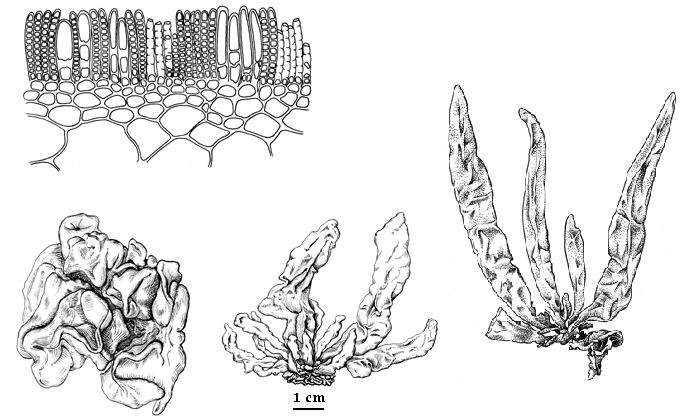Colpomenia bullosa
(D.A. Saunders) YamadaKey Characteristics
- Upright, finger-like, hollow, folded sacs from a common broad base
Image Gallery (click for more)
Database links
- Blue markers: specimen records
- Yellow marker: type locality, if present
- Red markers: endpoints of range from literature
View map from the Consortium of Pacific Northwest Herbaria
Notes: From Kismaliuk Bay, Unalaska Island (UBC A88175) to San Luis Obispo Co. Baja California, Mexico specimens (rare) may represent C. phaeodactyla.
Status: Confirmed by molecular studies from Agate Beach, Marin Co., California (Lee et al. 2012) and San Juan Island, Washington (Lee et al. 2014).
Habitat: Mid-intertidal bedrock in sheltered to moderately exposed environments
Life History: Probably alternation of heteromorphic phases, with zoospores from unilocular sporangia on macroscopic sporophytes germinating to produce tufts of diffusely branched filaments bearing plurilocular organs, subcultures of which produced successive generations of presumed plethysmothalli bearing both unilocular and plurilocular organs; macroscopic sporophytes not obtained in culture (Wynne 1972a).

Illustration from DeCew's Guide to the Seaweeds of British Columbia, Washington, Oregon, and Northern California


Colpomenia Derbès & Solier 1851
Thalli globular or saccate, with broad basal attachment, at first solid, later becoming hollow. Walls several to many cells thick. Inner cells large and colorless, progressively smaller and more pigmented outwardly. Plurangia at first limited to areas around hair tufts, later forming extensive surface areas. Unicellular, colorless paraphyses frequent among plurangia. Unangia unknown.
Colpomenia bullosa (Saund.) Yamada
Scytosiphon bullosus Saunders 1898: 163. Colpomenia bullosa (Saund.) Yamada 1948: 6; Hollenberg & Abbott 1966: 22. C. sinuosa f. deformans Setchell & Gardner 1903: 242.
Thalli olive tan to medium brown, to 10 cm tall, with 1 to several fingerlike hollow divisions from a common base, usually only 1 or 2 of these maturing; detailed structural and reproductive features not well known.
Occasional on midtidal rocks, N. Japan and Alaska to C. Calif. Type locality: Pacific Grove, Calif.
This troublesome species is considered by Wynne (1972) to be conspecific with C. peregrina.
Excerpt from Abbott, I. A., & Hollenberg, G. J. (1976). Marine algae of California. Stanford University Press, Stanford, California. xii [xiii] + 827 pp., 701 figs.
Notes: This species is distinct from C. peregrina and C. phaeodactyla (see illustrations).
NON-NATIVE
Vertical Distribution: Mid-intertidal
Frequency: Infrequent, though sometimes locally abundant
Substrate: Rock
Type locality: Pacific Grove, Monterey Co., California
